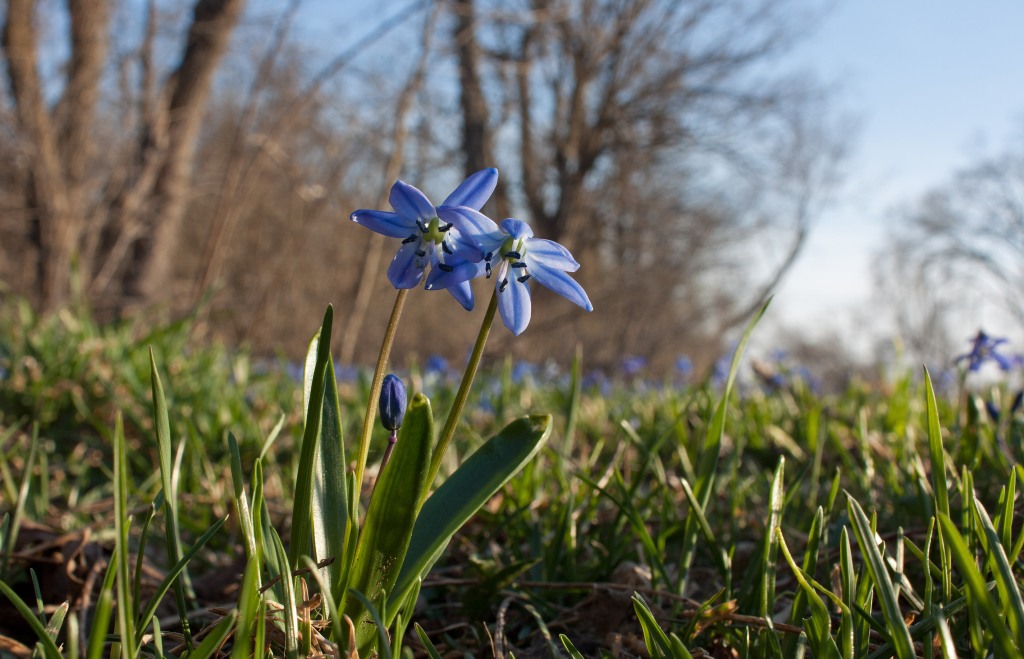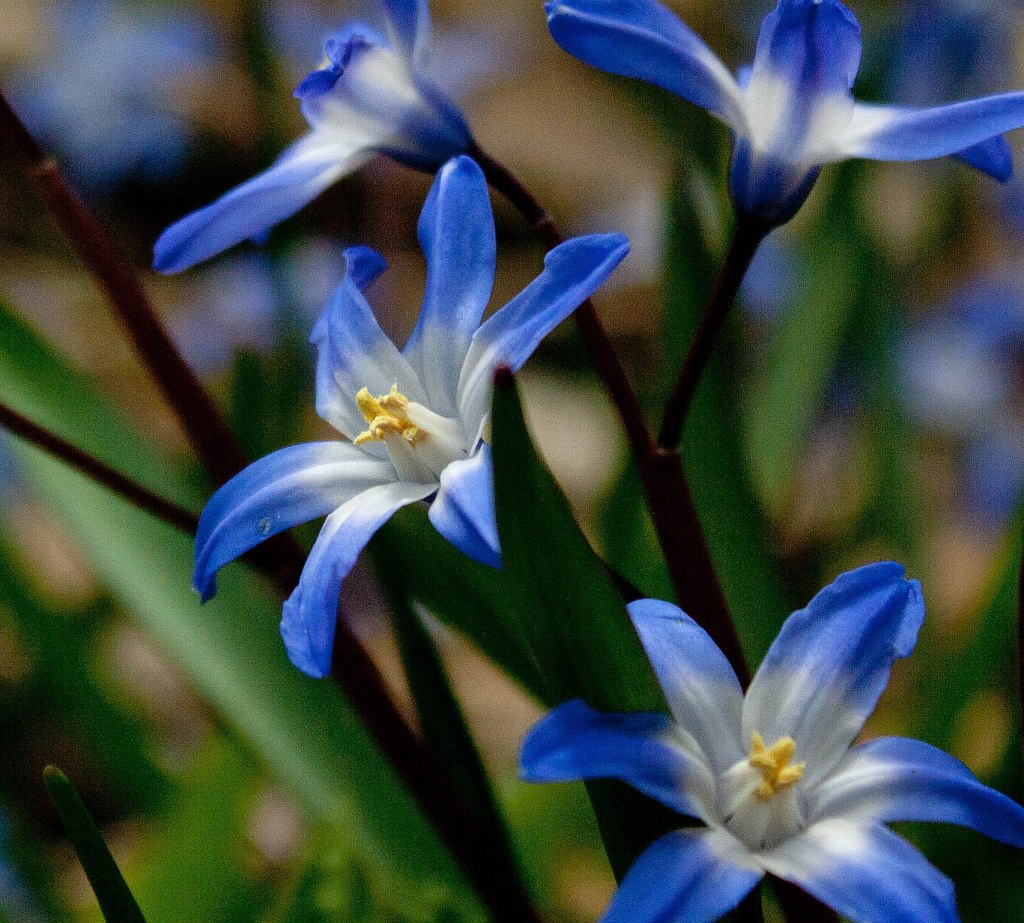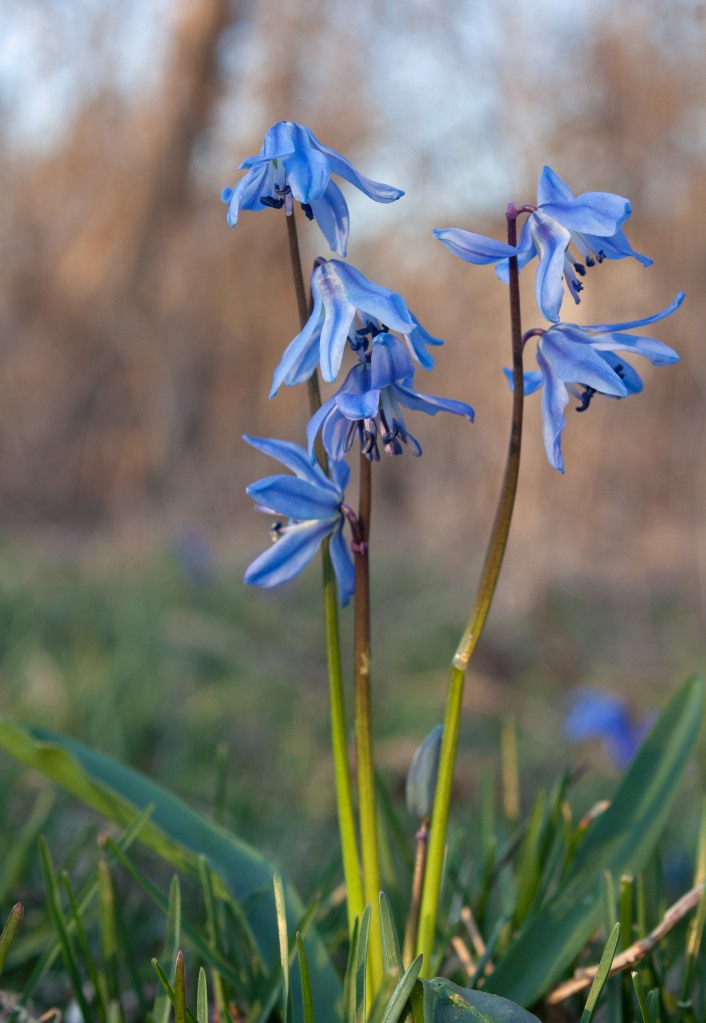One of the joys of spring is encountering nature’s wild flowers in my walks through the local forest in Peterborough, Ontario. One of the early spring flowers that appeared with the sudden warm weather in April is a delicate and beautiful blue flower called Scilla.
Scilla is a bulb perennial plant in the Asparagaceae family that is native to woodlands, subalpine meadows and seashores throughout Europe, Africa and the Middle East. But some have made it to North America and I ran across two of them on my walk along the Rotary trail in the Peterborough forest. Both species are blue to purple (depending on the light) but I’ve also seen a white variety flourishing in front of a house nearby. Most of the scillas are frost-hardy and rather prolific, providing wonderful ground cover. As with many asparagus plants, most scillas are poisonous; for this reason they are left alone by potential browsers.
The first species that I spotted in a recently cleared meadow, covered in wood chips, was Scilla luciliae, a prolific perky and graceful star-shaped bright blue flower that faces up and grows in loose clusters on unleafed, smooth stems. The base of each tepal and its clustered stamen filaments are white, producing a white ‘eye’. The outer part of the tepals is lilac blue to violet.
Also known as Lucile’s glory-of-the-snow, the plant, like all the scillas, is frost hardy and originates from western Turkey. Its name comes from Lucile, the wife of the Swiss botanist Pierre Edmond Boissier, who first described the species as a flower that blooms in the snow. Often sprouting at snow melt, S. luciliae is attractive to bees, bumblebees and other insects and provides nectar and pollen as one of the earliest flowers for them.
Farther down on the trail, on the edge of a black locust forest, I saw the second scilla species, Scilla siberica. Also called wood squill or Siberian squill, Scilla siberica is a bulbous perennial with delicate nodding bell-like flowers (3-4 per stem) each with six intense blue tepals (between a sepal and petal) and six stamens with white filaments and dark blue anthers (and pollen). Its white variety S. siberica var. alba is likely what I saw on the front lawn of a house close by. Scilla siberica can be distinguished from Scilla bifolia by its nodding flowers (the flowers of S. bifolia are upward-facing and have two lance-shaped leaves). S. siberica is cultivated for its bluebell-like flowers and naturalizes rapidly from seed, forming large colonies in grass. S. siberica is a vigorous, cold tolerant plant that is generally left alone by voles and deer. It’s considered one of the most winter-hardy of the scillas.
Partly because of its hardiness and fast spread—possibly at the expense of some native woodland species—Scilla siberica is considered an invasive in Minnesota and Midwestern United States, and since 2018 also in Ontario Canada where I live. This has often engendered lively discussion: some finding them offensive and adamantly arguing for total eradication while others finding them beautiful and wishing only to leave them in peace. Some sources contend that S. siberica is crowding out native woodland species such as Hepatica and bloodroot; I find this hard to accept, given that at least where I live in the Kawarthas of Canada they do not occur in the same habitat or occupy the same niche. Scilla is most successful in the verge, where forest meets field, disturbed environments recently changed by humans. They are most likely runaway cultivars, associated with human disturbance. Hepatica is a deep wood species that does not fair well with disturbance, which makes the argument of one replacing the other untenable. It is more likely that other factors are at play that determine the success of one and not the other.
This begs the question: what is it really that we need to eradicate?
Invasive or Noninvasive and What Does That Mean?
Wandering in Canada poses the question “Is Scilla siberica invasive?” and explains the meaning of invasive:
Disagreement about whether or not to list a species as ‘invasive’ arises from the difficulty of determining what precisely an ‘invasive’ species is, and the philosophical and moral debate about what we should do about it. In ecological terms, in order to qualify as invasive, a species must be (a) outside of its native range and (b) spreading to the detriment of native species. The first criterion is easy enough to judge, provided there is a historical record or some other straightforward evidence of the species’ native status. The second criterion is much harder. It takes a lot of research to establish that (a) native populations are suffering and (b) the suffering is caused by the introduced species.
The Ontario government defines invasive species more broadly and also less definitively as “harmful alien species whose introduction or spread threatens the environment, the economy, or society, including human health.” Much interpretation is needed with this definition.
Wandering in Canada gives the example of S. siberica forming high-density populations in sites which have been previously occupied by native spring ephemerals such as Trillium spp., Sanguinaria Canadensis, which are showing drops in populations and other metrics of health.
But they also make the point that these two facts don’t establish a causal link. They are just co-occurring. To establish cause, one must first eliminate all other potential reasons why one plant will flourish while another doesn’t. In a natural open system, there are many reasons for this. Obvious ones include: habitat changes and disturbance (e.g. activities that cause chemical pollution, air quality changes, deforestation and changes in forest ecosystem structure—all which will differentially effect plants according to their sensitivities), climate change, insect predation, fungal infections, deer predation, and more. In other words, in the above example given by Wandering in Canada, the diminishing populations of certain native spring flowers might occur regardless of the presence of Scilla because of other environmental perturbations; it may be that all Scilla is doing is taking advantage of an opening niche to occupy. A 2022 article by Margaret Roach in the New York Times reported that native trillium species are threatened primarily by human development, and predation by deer and feral hogs, while acknowledging increasing competition by invasive plants.
A major shuffle in biota structure and function is happening now—mostly due to climate change and human development/disturbance. Scientific literature already provides many examples of climate-change induced changes in temporal and spatial niche partitioning among organisms with differing sensitivities. Examples of lateral movement and reshuffling within an ecosystem is likely to increase with climate change and with more human-related disturbance — as the ecosystem itself responds to these perturbations.
In Ontario, where I live, S. siberica flourishes in the verges of the local woodland near me. Those forests are themselves disturbed ecosystems and populated by hardy and, in many cases, invasive species that include Common Buckthorn, Black Locust, Scots Pine, Tatarian Honeysuckle, Dames Rocket, Periwinkle, Bull Thistle, and others. Attempts to eradicate one or several invasive species seems a naïve approach, given that these invaders are just one symptom of a much larger ailment: habitat disturbance resulting in over-simplification of an ecosystem.
The flourishing of each component of a natural ecosystem relies on a healthy, biodiverse, and resilient ecosystem. It is the entire ecosystem we must scrutinize. Is it sufficiently large, robust, and complex to protect it from human interference?
Because we are the invasive species.
Time to look at the bigger picture.

Nina Munteanu is a Canadian ecologist / limnologist and novelist. She is co-editor of Europa SF and currently teaches writing courses at George Brown College and the University of Toronto. Visit www.ninamunteanu.ca for the latest on her books. Nina’s bilingual “La natura dell’acqua / The Way of Water” was published by Mincione Edizioni in Rome. Her non-fiction book “Water Is…” by Pixl Press (Vancouver) was selected by Margaret Atwood in the New York Times ‘Year in Reading’ and was chosen as the 2017 Summer Read by Water Canada. Her novel “A Diary in the Age of Water” was released by Inanna Publications (Toronto) in June 2020.





I miss the line of thought that native plant species are endangered by deer because invasive plants take up space while not getting eaten by deers, so there is less spreading ground for native species, so less food for deers. Same for bees, who may feed on introduced plants but cannot get the same nutritious amounts out of them as they can get from native plants. Scilla are all over the place in Toronto and now also the GTA. While there are many factors at play, I wish humans would acknowledge that their wish for “beautiful flowers” is not a good reason to deliberately introduce or encourage the spread of plants that disturb the natural balance of ecosystems.
LikeLike
I fully agree with what you say; the point I make in my article is that we must look at the larger picture of disturbance. That Scilla are all over the place is not so much Scilla being a bully and taking over. Scilla and other invasive species are taking advantage of an already disturbed environment; and that is the point I’m making. If we want to protect native plants, we must protect their native ecosystems. If we can’t do that, there is no point in making these invasives the bad guys here; we’ve already been the bad guys here. The areas where I see Scilla thriving are highly disturbed ecosystems. That’s why they are there; that’s on us. And THAT is the problem.
LikeLike